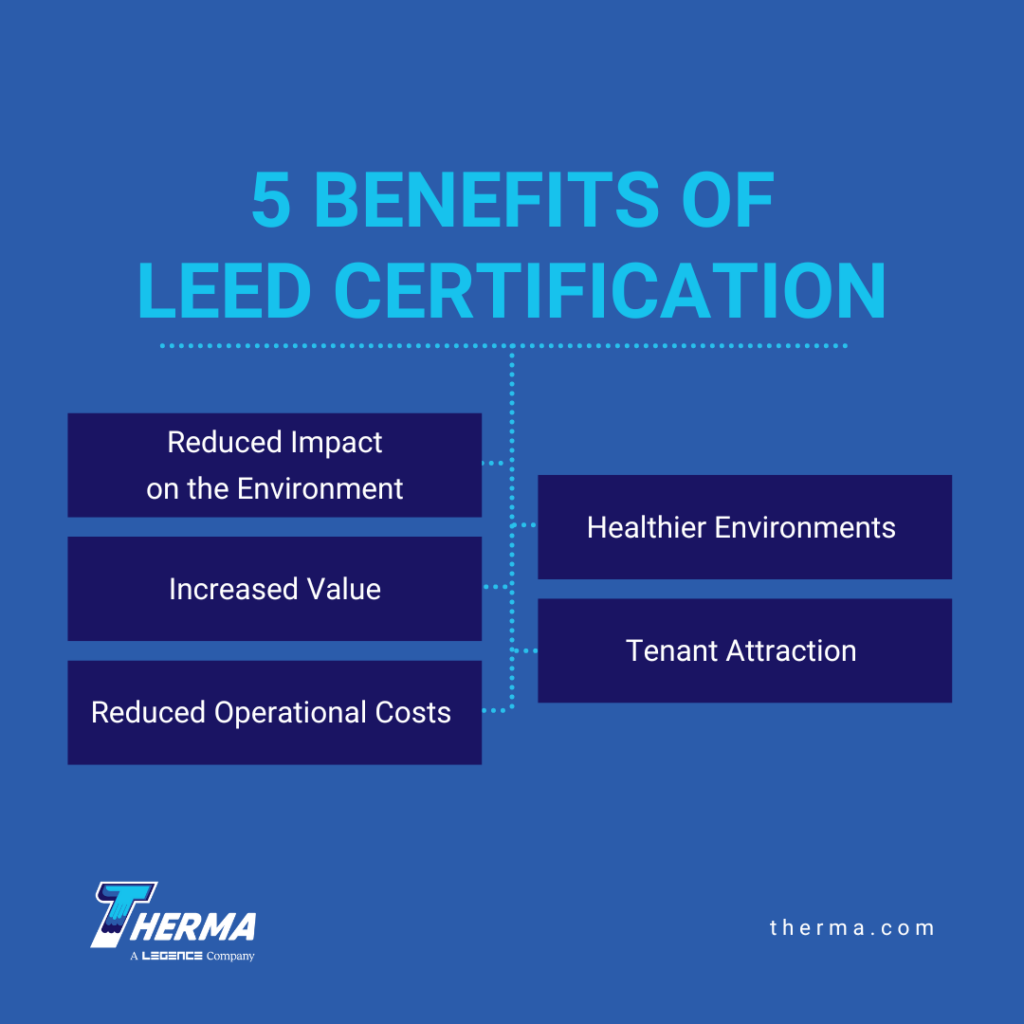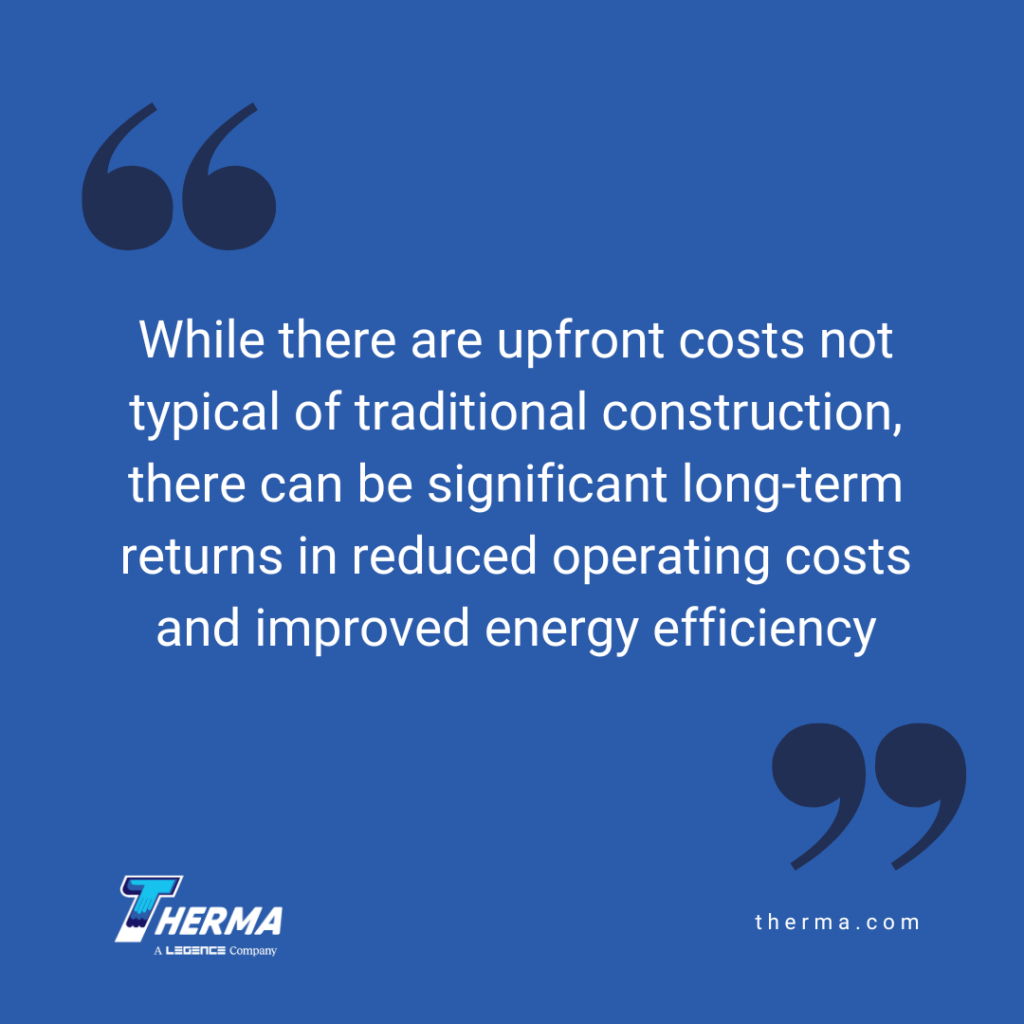More than 100,000 buildings are certified to the US Green Building Council’s Leadership in Energy and Environmental Design (LEED) standards globally. These include museums, hospitals, homes, and schools that have all harnessed the benefits of LEED Certification. In this article, we’ll look at how adding LEED projects to your portfolio can create business value.
What is LEED Certification?
Created by the United States Green Building Council (USGBC), the LEED certification rating system is a framework for green buildings that provides guidance for environmental, social, and economically beneficial design and construction elements. LEED certification is earned by implementing measures that encourage energy efficiency, occupant wellness, and conservation of resources.
LEED-certified buildings implement design and system selections that reduce energy usage, improve indoor air quality, and protect natural ecosystems. These can include exterior features such as stormwater management elements like green roofs and native landscaping. Thoughtful attention to material and finish selections–like low-VOC (volatile organic compound) paint–reduces indoor contaminants and allergens to create better indoor air quality for occupants. Renewable energy such as solar PV and geothermal HVAC are also examples of ways buildings can capture LEED certification points.
LEED Certification is a designation that conveys a building’s or even neighborhood’s commitment to sustainable design and operations. LEED Certification requires design and construction to meet the standards of a LEED rating system. There are several categories and levels of certification, making it possible for almost any type of project to earn LEED Certification.
LEED rating systems can be for new construction and major renovations, interior design, building operations, neighborhoods, homes, and cities. Within each rating system, there are four levels of certification: 40-49 earns a LEED certified rating, LEED Silver is awarded at 50-59 points, Gold at 60-79 points, and Platinum at 80 points or more. All LEED certification levels recognize high-performance buildings that exceed traditional building standards.
5 Benefits of LEED Certification for Green Buildings
The benefits of pursuing LEED certification are both quantitive and qualitative. While there are upfront costs not typical of traditional construction, there can be significant long-term returns in reduced operating costs and improved energy efficiency. With state and federal incentives, the initial investments can be offset creating significant returns over a building’s lifespan. Additionally, LEED-certified buildings create goodwill for the benefits they bring to their communities and the environment. While this may not always be quantified, it can be a unique selling point in marketing to consumers and investors.
1. Reduced Operational Costs
As high-performance structures, LEED-certified buildings can have highly efficient envelopes with sophisticated glazing systems. These types of features help decrease energy used for heating and cooling. Add other energy-saving features like Energy Star appliances and LED lighting and you have a building that is 30-60% more energy efficient. This can create operational savings that add up over time.
2. Increased Value
In a recent survey, researchers discovered that the value of homes with LEED certifications in California was on average 9% higher than those without green certifications between 2007 and 2012. Commercial buildings like multi-family rental properties sell for a higher rate — about 20% more than units in non-certified buildings.
3. Healthier Environments
LEED Certification requires tight building envelopes and advanced filtration systems that improve the quality of indoor air. Depending on where you are, the Environmental Protection Agency estimates that indoor air is two to ten times more polluted than outdoor air. LEED-compliant buildings have fewer airborne pollutants as well as less mold and mildew. Studies show that this leads to happier, healthier employees who are more productive.
4. Reduced Impact on the Environment
LEED-certified buildings use less energy and some even produce much of their own energy from renewable, onsite sources. There is also a reduction in water consumption thanks to Energy Star appliances, low-flow plumbing fixtures, and stormwater management features such as rain gardens. Recycling and waste reduction features are part of every LEED Certified project. To date, LEED-certified buildings have diverted more than 80 million tons of waste from landfills.
5. Tenant Attraction
Studies show that millennials would take a pay cut to work for a company that was more sustainable. Many employees and tenants value sustainability as an important contributing factor when selecting a building to live or work in or a job they would like to do. Facebook’s LEED Platinum HQ is a prime example of how companies can create a strong brand identity and attract talent through their sustainable facilities.
How to Become LEED Certified
The process for acquiring LEED Certification has several steps and the timeline depends on the length of design and construction. First, you’ll need to register with the USGBC and complete an orientation. Depending on the type of rating you choose, and whether you are a USGBC member, you will pay the corresponding registration fee and then submit all the documentation. Once the project documentation has been received, your project will be reviewed by the Green Business Certification Inc. (GBCI).
While this process is laid out clearly on the USGBC website, it does require specialist knowledge and can be time intensive. In order to get the most out of your investment, it is helpful to seek the help of a professional experienced consultant, like Therma, who is able to seamlessly shepherd you through this process. Contact us today!
Nikki Fotheringham is an environmental journalist and cookbook author. She is the editor of Greenmoxie.com where she shares green-living tips and helps people to live a more sustainable life.
Sources:
U.S. Green Building Council (USGBC) – Brand
U.S. Green Building Council (USGBC) – Guide to LEED Certification: Volume
Dickinson College – Benefits of LEED
LA Times – Green-certified homes sell for 9% more, study in California finds
ConstructionDive – Building to LEED could raise a home’s resale value
Environmental Protection Agency (EPA) – The Inside Story: A Guide to Indoor Air Quality
Journal of Asian Architecture and Building Engineering – Indoor Environmental Quality in LEED-Certified Buildings in the U.S









